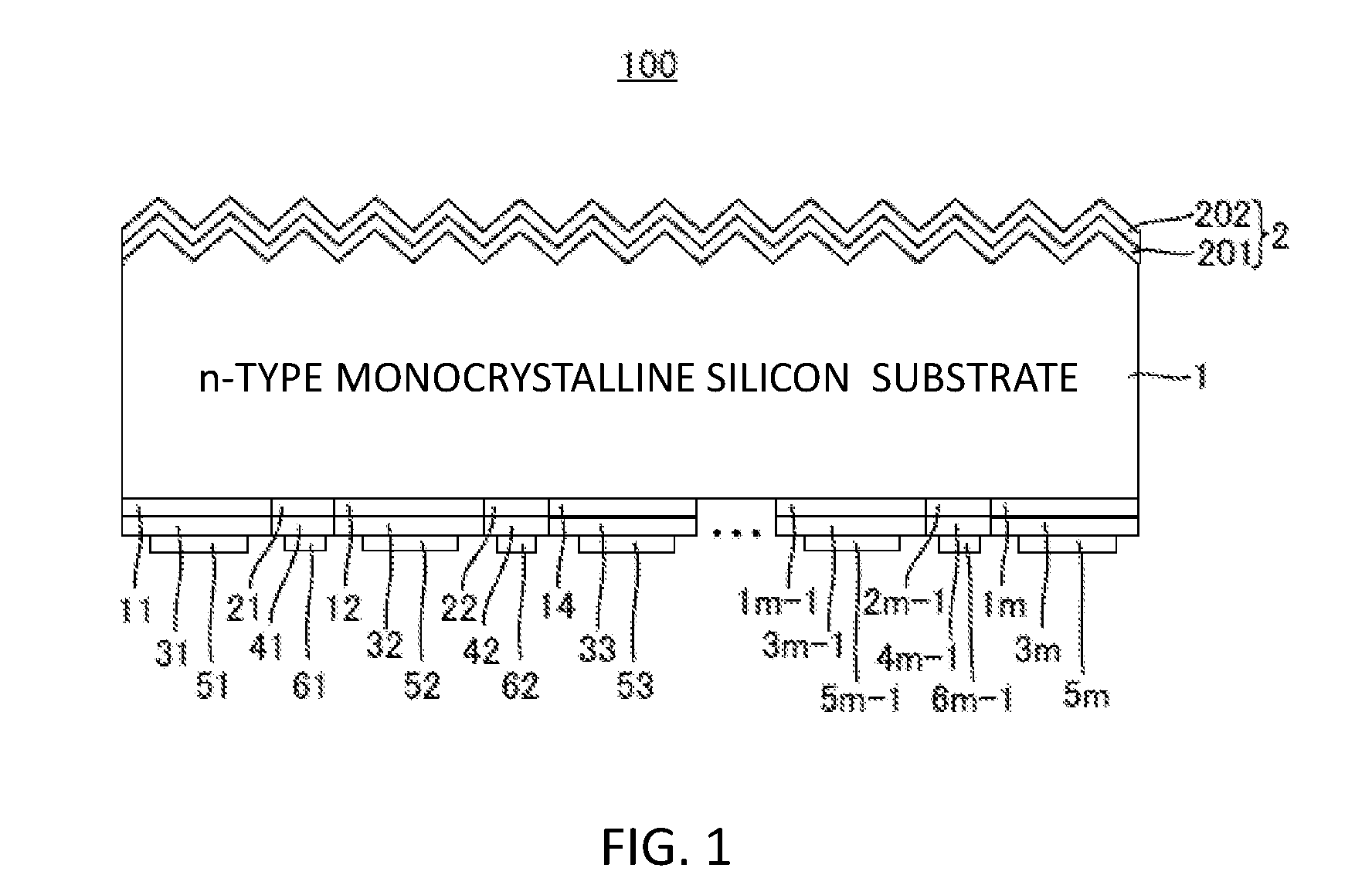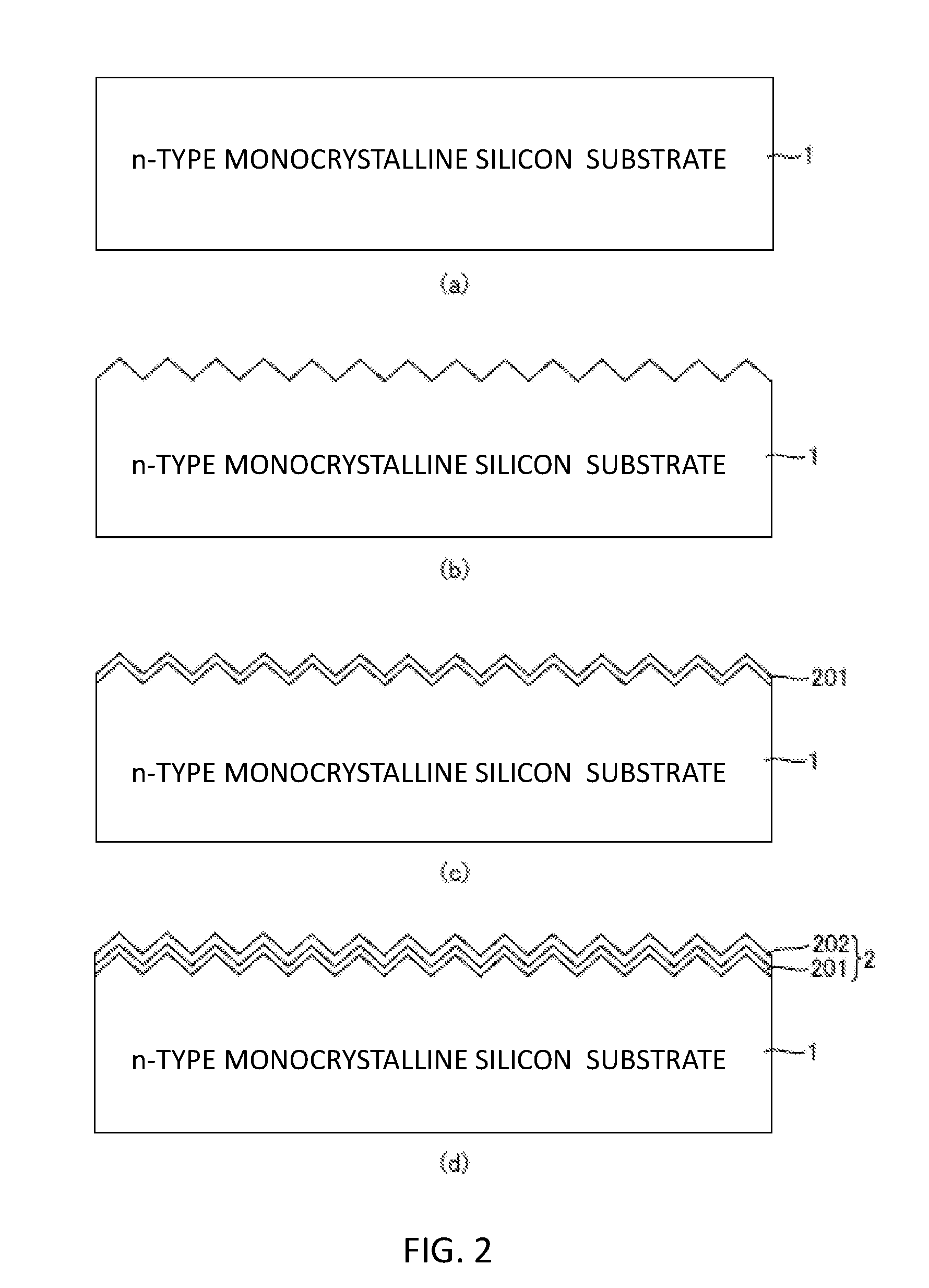Photoelectric conversion element
a conversion element and photoelectric technology, applied in the direction of sustainable manufacturing/processing, climate sustainability, semiconductor devices, etc., can solve the problems of reducing the passivation effect of monocrystalline silicon substrates, reducing the characteristics of solar cells, etc., to reduce thermal strain, reduce the effect of carrier characteristics, and improve the passivation characteristics of semiconductor substrates
- Summary
- Abstract
- Description
- Claims
- Application Information
AI Technical Summary
Benefits of technology
Problems solved by technology
Method used
Image
Examples
first embodiment
[0076]FIG. 1 is a sectional view illustrating a configuration of a photoelectric conversion element according to a first embodiment of the invention. With reference to FIG. 1, a photoelectric conversion element 100 according to the first embodiment of the invention includes an n-type monocrystalline silicon substrate 1, an non-crystalline thin film 2, i-type non-crystalline thin films 11 to 1m and 21 to 2m−1 (m is an integer greater than or equal to two), p-type non-crystalline thin films 31 to 3m, n-type non-crystalline thin films 41 to 4m−1, and electrodes 51 to 5m and 61 to 6m−1.
[0077]The n-type monocrystalline silicon substrate 1 has, for example, a (100) plane orientation and a resistivity of 0.1 Ω·cm to 1.0 Ω·cm. The n-type monocrystalline silicon substrate 1 has, for example, a thickness of 50 μm to 300 μm and preferably a thickness of 80 μm to 200 μm. The surface on the light incident side of the n-type monocrystalline silicon substrate 1 is texturized.
[0078]The non-crystall...
second embodiment
[0158]FIG. 10 is a sectional view illustrating a configuration of a photoelectric conversion element according to a second embodiment. With reference to FIG. 10, a photoelectric conversion element 200 according to the second embodiment is the same as the photoelectric conversion element 100 except that the i-type non-crystalline thin films 11 to 1m of the photoelectric conversion element 100 illustrated in FIG. 1 are removed.
[0159]In the photoelectric conversion element 200, the p-type non-crystalline thin films 31 to 3m are arranged in contact with the n-type monocrystalline silicon substrate 1.
[0160]FIG. 11 and FIG. 12 are partial process charts for manufacturing the photoelectric conversion element 200 illustrated in FIG. 10.
[0161]The photoelectric conversion element 200 is manufactured in accordance with a process in which Process (e) to Process (i) of Process (a) to Process (k) illustrated in FIG. 2 to FIG. 4 are respectively replaced by Process (e-1) to Process (i-1) illustrat...
third embodiment
[0176]FIG. 13 is a sectional view illustrating a configuration of a photoelectric conversion element according to a third embodiment. With reference to FIG. 13, a photoelectric conversion element 300 according to the third embodiment is the same as the photoelectric conversion element 100 except that the i-type non-crystalline thin films 21 to 2m−1 of the photoelectric conversion element 100 illustrated in FIG. 1 are removed.
[0177]In the photoelectric conversion element 300, the n-type non-crystalline thin films 41 to 4m−1 are arranged in contact with the n-type monocrystalline silicon substrate 1.
[0178]FIG. 14 and FIG. 15 are partial process charts for manufacturing the photoelectric conversion element 300 illustrated in FIG. 13.
[0179]The photoelectric conversion element 300 is manufactured in accordance with a process in which Process (e) to Process (i) of Process (a) to Process (k) illustrated in FIG. 2 to FIG. 4 are respectively replaced by Process (e-2) to Process (i-2) illustr...
PUM
 Login to View More
Login to View More Abstract
Description
Claims
Application Information
 Login to View More
Login to View More - R&D
- Intellectual Property
- Life Sciences
- Materials
- Tech Scout
- Unparalleled Data Quality
- Higher Quality Content
- 60% Fewer Hallucinations
Browse by: Latest US Patents, China's latest patents, Technical Efficacy Thesaurus, Application Domain, Technology Topic, Popular Technical Reports.
© 2025 PatSnap. All rights reserved.Legal|Privacy policy|Modern Slavery Act Transparency Statement|Sitemap|About US| Contact US: help@patsnap.com



